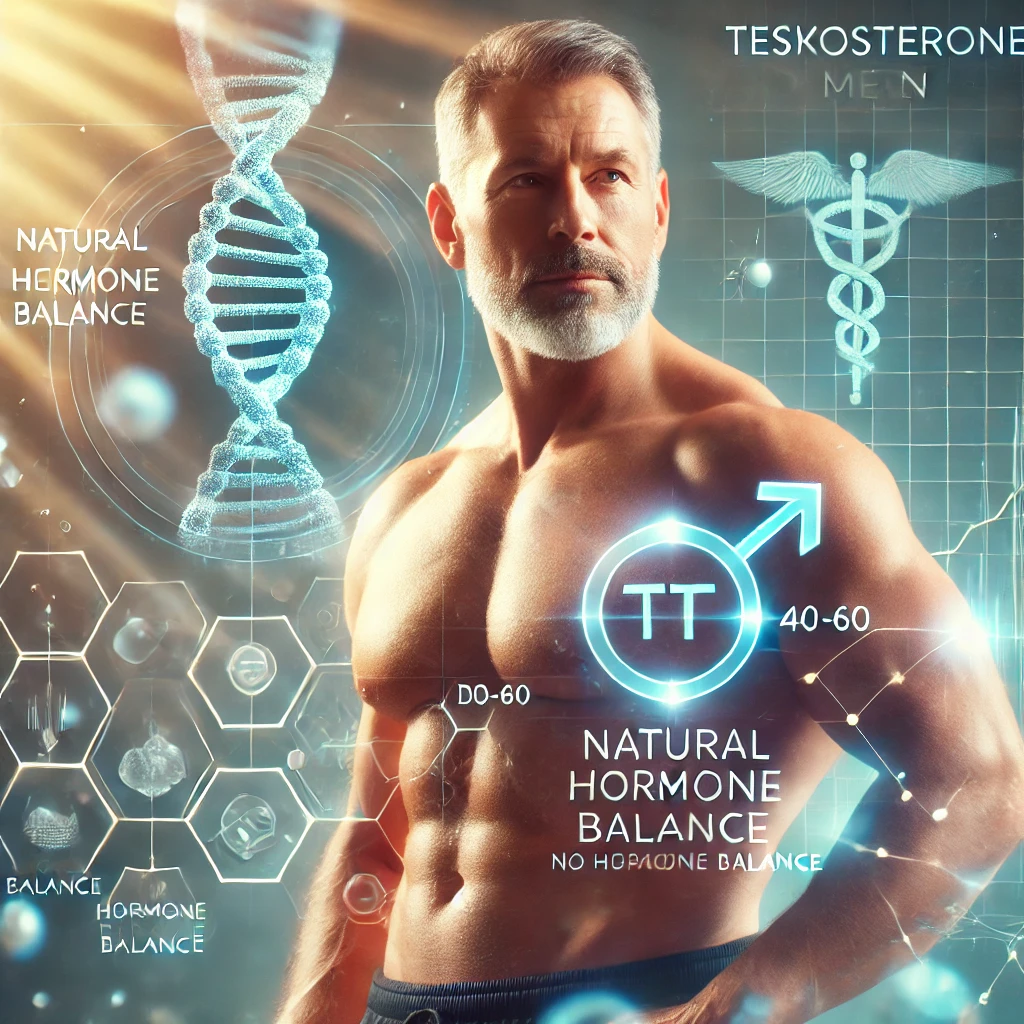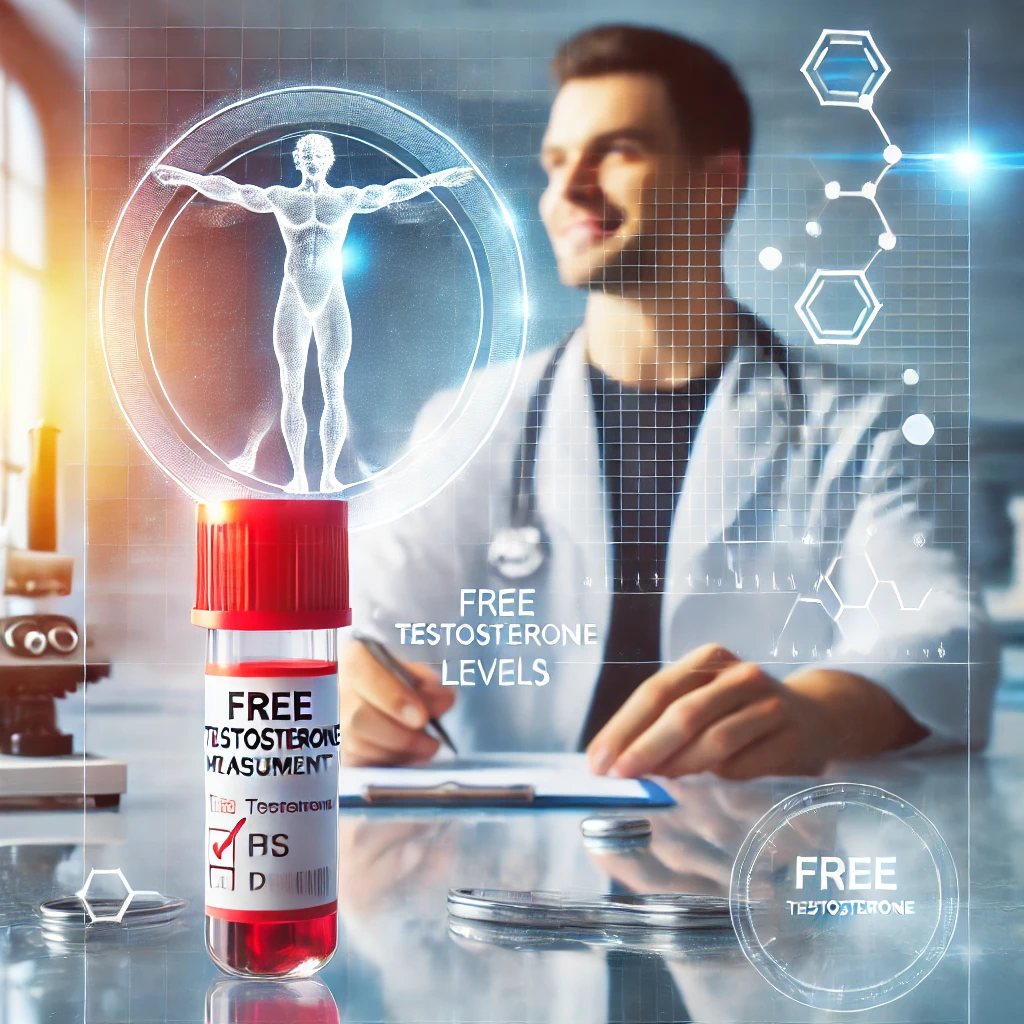Ever heard the term “free testosterone” and wondered what it’s really about? You’re definitely not alone. Understanding what is free testosterone can feel a bit like unlocking a hidden level in a video game—suddenly, you realise there’s more going on behind the scenes!
Simply put, free testosterone is the active form of testosterone floating freely in your bloodstream, not bound to proteins. Without healthy levels of free testosterone, it’s like trying to shoot a gun with no bullet! What is free testosterone? It’s the bullet in the gun.
Even though it makes up only 2-5% of your total testosterone, it’s this “free” testosterone that powers your energy, mood, and even your muscle mass. Think of it as the ready-to-use fuel your body needs to function at its best. It is the unbound version of testosterone (hence it’s free)
Now, here’s where it gets interesting: knowing your free testosterone levels can offer key insights into your overall health and vitality. It helps you keep your hormones in balance, which is essential for men over 40 who want to optimise their health. And trust me, whether you’re chasing after the best gym results or simply trying to maintain your edge, free testosterone is one player you don’t want to overlook.
Key Takeaways: What Is Free Testosterone?
As we wrap up, here are the main points to remember when asking what is free testosterone?
1. Understanding Free Testosterone: Free testosterone is the active form of testosterone in your bloodstream, unbound by proteins and ready to perform its job. Though it makes up only a small portion of your total testosterone, its impact on your health is substantial.
2. Health Impacts: From muscle mass to mood regulation, free testosterone plays a vital role in overall well-being, especially for men over 40. Knowing your levels can help keep your energy and vitality in check.
3. Symptoms of Imbalance: Watch for signs of low or high free testosterone, such as fatigue, changes in muscle mass, or mood swings. Recognising these symptoms early can help you take control of your health.
4. Testing and Treatment: Regular testing is key to understanding your free testosterone levels. If you’re experiencing symptoms, simple blood tests can provide clarity. From Hormone Replacement Therapy to lifestyle changes, there are several ways to manage testosterone levels effectively.
5. Living Well with Balanced Testosterone: Maintaining your testosterone balance is crucial for long-term health. By staying informed, you’re empowering yourself to make smarter decisions about your well-being.
Understanding Testosterone

When people hear the word testosterone, they often think of it as that one-dimensional hormone associated with masculinity. But it’s way more complex than that.
In fact, testosterone is a key hormone that impacts both men and women, playing a role in everything from mood regulation to muscle growth. So if you thought testosterone only mattered for bodybuilders, think again. This section will break down the different types of testosterone and explain why free testosterone is the MVP of hormones. You’ll understand why you can suffer from low testosterone, but own healthy free T levels and feel perfectly fine.
What is Testosterone?
So, what is testosterone exactly? Testosterone is a steroid hormone primarily produced in the gonads—testicles in men, ovaries in women. It’s like the body’s master controller for puberty, driving the transition from boy to man with those tell-tale physical changes.
But even beyond puberty, testosterone continues to play a massive role in supporting muscle mass, bone density, and mood balance in adults.
Think of it like this: testosterone is your personal power-up. Got the energy to push through that extra gym set or tackle a tough day at work? You can probably thank your testosterone levels for that. It also influences key behaviours and brain functions, making it a jack-of-all-trades when it comes to keeping you sharp and feeling your best.
Types of Testosterone
Not all testosterone is created equal. In fact, it’s split into different types, each playing its own unique role in your body’s overall function. Here’s a quick breakdown:
1. Total Testosterone: This is the grand total of testosterone in your bloodstream. It includes both the testosterone that’s attached to proteins (bound) and the type that’s free-floating and ready to be used.
2. Free Testosterone: Here’s the star of the show. Free testosterone is the unbound hormone that’s available for immediate use. Imagine it like cash in your pocket—ready to spend, as opposed to money locked in a savings account.
3. Bioavailable Testosterone: This is both free testosterone and testosterone loosely bound to proteins like albumin. It’s accessible, but not as immediately available as free testosterone—kind of like using a credit card instead of cash.
Each of these types plays a specific role, impacting everything from muscle growth to how we feel day-to-day. Understanding your body’s unique balance of these testosterone types can give you the upper hand in optimising your health.
What is Free Testosterone?
Ever wondered what’s really happening with testosterone in your body? Well, let’s take a closer look at what is free testosterone and why it’s so important. Despite making up just a small fraction of your total testosterone, free testosterone is what your body relies on to regulate critical functions like mood, energy, and even muscle growth. It’s the active form that isn’t tied down to proteins and can jump into action whenever your body needs it.
Definition of Free Testosterone
Think of free testosterone as the “roaming cowboy” of your body—it’s the part of testosterone that isn’t tethered to proteins like albumin or SHBG (sex hormone-binding globulin).
This freedom makes it highly active and essential to many bodily functions. While most testosterone is bound to proteins and stays inactive, free testosterone is always ready to be used. It’s like having a sprinter in the background, primed to jump into action when needed.
Biological Role of Free Testosterone
So, now we understand the answer to what is free testosterone…. what does free testosterone actually do? Well, think of it as your body’s secret weapon. From keeping your muscle mass in check to maintaining your energy levels and even regulating your mood, free testosterone is vital and is responsible for the many positive effects of testosterone.
- Muscle and Bone Health: Free testosterone helps build muscle and strengthen bones. Whether you’re an athlete or just trying to stay active, it’s this hormone that gives you an edge.
- Mood and Energy: Ever had one of those days where your energy is through the roof? That’s free testosterone at work. On the flip side, low levels can leave you feeling sluggish or even depressed.
- Libido: Yes, free testosterone plays a key role in regulating your sex drive, keeping romantic desires healthy and lively.
It’s easy to overlook this little hormone powerhouse, but as you can see, free testosterone does a lot of the heavy lifting behind the scenes.
Free testosterone plays a critical role in regulating sexual desire and function, with low levels often leading to reduced libido and erectile dysfunction in men.”
— Source: Harvard Medical SchoolTestosterone is essential for maintaining bone density, with low levels leading to osteoporosis and an increased risk of fractures, particularly in aging men.”
— Source: National Osteoporosis Foundation
How is Free Testosterone Measured?

Curious about how doctors actually measure your free testosterone levels? It’s not as simple as reading a thermometer. Most doctors use blood tests to specifically check how much testosterone in your bloodstream is “free” and unbound. There are a couple of methods they use:
1. Direct Equilibrium Dialysis: This is considered the gold standard. It measures free testosterone directly, but it takes longer and costs more.
2. Calculations Based on Total Testosterone and SHBG: This method is more common and quicker. Labs calculate free testosterone based on your total testosterone and SHBG levels.
By keeping an eye on your free testosterone, you can ensure everything’s in balance and catch potential issues early.
Free T Measurements in UK and US Countries
When it comes to measuring free testosterone levels, there are slight differences between how it’s done in the UK versus the US. In both countries, free testosterone is typically measured using a blood test, but the methods and units of measurement can vary.
In the UK, free testosterone is often measured in nanomoles per litre (nmol/L). Labs will typically use the calculated free testosterone method, which takes your total testosterone and SHBG (sex hormone-binding globulin) levels into account to estimate the amount of free testosterone. This method is more widely used due to its affordability and speed, though direct methods like equilibrium dialysis are considered more accurate.
In the US, the most common unit for measuring free testosterone is picograms per millilitre (pg/mL). The US healthcare system also frequently uses calculated free testosterone, but direct equilibrium dialysis is more readily available for cases that require precise measurements, such as for those undergoing testosterone replacement therapy.
Average to Optimal Free Testosterone Levels for Men Aged 40-60
For men aged 40 to 60, free testosterone levels naturally decline, but understanding the range can help you determine whether your levels are in the average or optimal range. In the UK, normal free testosterone levels for men in this age group are typically considered to be between 0.2 and 0.62 nmol/L.
In the US, the average range is about 50 to 210 pg/mL, with levels above this being considered optimal. However, optimal levels can vary depending on individual health, lifestyle, and fitness goals.
If your levels fall below these averages, you might notice symptoms such as low energy, reduced muscle mass, or mood changes. It’s important to consult with a healthcare provider if you’re concerned about your levels or if you’re experiencing any of the common signs of low free testosterone.
Factors Affecting Free Testosterone Levels

So what influences your free testosterone levels? There are a lot of factors, and keeping them in check can be crucial to maintaining a balanced body. Testosterone, particularly free testosterone, is more than just a “manly hormone”—it impacts everything from your energy to your mood. Let’s break down some of the most important influences:
- Age: As we get older, our testosterone levels naturally decline. Starting in your late 20s, testosterone drops by about 1% each year. By the time you hit 40, you might notice a difference in your energy and muscle strength, thanks to lower levels of free testosterone.
- Health Conditions: Conditions like obesity, diabetes, and hormonal imbalances can lower free testosterone. Excess fat, especially around the belly, converts testosterone into oestrogen, throwing your hormonal balance off.
- Lifestyle Factors: What you eat, how often you exercise, and your stress levels can all impact free testosterone. For instance, regular weightlifting boosts testosterone, but too much exercise can stress your body out, lowering your levels.
Testosterone levels decrease by about 1% per year after age 30, contributing to loss of muscle mass, reduced energy, and mood changes.”
— Source: American Urological AssociationChronic stress increases cortisol, which negatively affects testosterone production. Reducing stress through relaxation techniques can help balance cortisol and testosterone levels.”
— Source: National Institutes of Health (NIH)
Symptoms of Abnormal Free Testosterone Levels
When everything’s running smoothly, testosterone quietly keeps your body in check. But when free testosterone levels fall out of balance—either too high or too low—the signs can be hard to miss. Let’s dive into what happens when your free testosterone isn’t where it should be.
Symptoms of Low Free Testosterone
Imagine your body’s energy supply as a battery. When free testosterone levels are low, that battery feels half-drained, even when you should be fully charged. Here’s what you might notice:
- Low energy and fatigue: It feels like you’re running on empty, struggling to get through the day.
- Reduced sex drive: Your usual romantic spark might fizzle out, leaving you feeling disconnected.
- Mood swings and depression: Feeling down more often or swinging between moods? Low free testosterone might be the culprit.
- Loss of muscle mass and strength: Despite your best efforts at the gym, you may find it harder to build or maintain muscle.
- Increased body fat: Especially around the belly area, your body starts storing more fat.
- Thinner hair or hair loss: Noticing more hair on your pillow or in your brush? Low testosterone levels can lead to thinning hair.
- Sleep disturbances: A good night’s sleep becomes elusive, leaving you tossing and turning.
- Brain fog: Struggling to focus or recall things clearly? Low free testosterone could be affecting your concentration.
Low testosterone levels are linked to depression, irritability, and cognitive decline, with studies showing that men with testosterone deficiency are more likely to suffer from these mood disorders.”
— Source: Endocrine SocietyTestosterone deficiency is associated with an increased risk of cardiovascular disease, as it affects lipid profiles, blood pressure, and inflammatory markers in men.” — Source: European Heart Journal
Symptoms of High Free Testosterone
On the flip side, too much free testosterone can lead to a range of symptoms that might feel like everything’s in overdrive:
- Aggression and mood changes: Feeling irritable or on edge more often than usual? High testosterone can ramp up aggressive behaviour.
- Excessive hair growth: Shaving more frequently or noticing hair in places you didn’t expect.
- Oily skin and acne: It’s like your teenage skin problems have made an unwanted comeback.
- Weight gain and increased muscle mass: While muscle gain might sound great, it can come with rapid weight gain that’s hard to control.
- Sleep pattern changes: High free testosterone can mess with your sleep, leaving you feeling restless.
- Decreased sperm production: In men, high testosterone can negatively impact fertility.
- Cardiovascular risks: An increase in testosterone levels can raise your blood pressure or cholesterol, potentially leading to heart issues.
Recognising these symptoms early on can help you take control of your health before things spiral. Knowing the signs is half the battle in managing your testosterone health effectively.
A lack of sleep reduces testosterone levels in men, with as little as one week of sleep deprivation reducing levels by up to 15%.”
— Source: Journal of the American Medical Association (JAMA)
Diagnosis and Treatment
Getting a handle on your free testosterone levels can feel a bit like troubleshooting a mysterious tech glitch—you know something’s off, but you need the right tools to figure it out. Let’s look at how testing works and what treatment options are available when your free testosterone isn’t quite right.
Testing for Free Testosterone

Testing your free testosterone levels is essential to understanding how your body’s functioning. Here’s how it’s done:
- Blood Test: The most common method is a blood test, usually done in the morning when testosterone is at its peak. It’s as easy as a quick trip to your doctor and can provide crucial insights.
- Bioavailable Testosterone Test: This measures both free testosterone and the testosterone that’s loosely bound to proteins. Think of it as a more detailed check that gives you a full picture of what’s going on.
If you’re experiencing any of the symptoms mentioned earlier, don’t ignore them—get tested. It’s like tuning your car engine to ensure everything is running smoothly.
Treatment Options for Low Free Testosterone
Once you’ve had your testosterone levels tested, treatment options depend on what’s causing the imbalance. Here are some ways to restore balance:
Lifestyle Adjustments
Sometimes, simple tweaks to your routine can make a world of difference:
- Fix Your Diet: Incorporating foods rich in micronutrients, like zinc and vitamin D can naturally boost your testosterone. You’ll also want to ensure you’re eating as a man should – moderate protein, higher mono and saturated fat and low sugar/processed carbs.
- Lose Body Fat: There’s a strong correlation between low testosterone and men holding more than around 17% body fat. Your body becomes more estrogenic in nature the higher levels of fat you hold.
- Exercise: Regular physical activity, especially strength training, can increase testosterone levels.
- Stress Management: Reducing stress through meditation or mindfulness can help lower cortisol levels, which in turn helps boost testosterone.
- Sleep Well: the correlation between sleep and testosterone is well documented.
Resistance training, particularly heavy weightlifting, has been shown to increase testosterone levels, with significant effects observed in men who regularly engage in strength training.”
— Source: Journal of Strength and Conditioning ResearchZinc and vitamin D are two critical nutrients that play a role in testosterone production, with studies showing that men deficient in these nutrients often experience lower testosterone levels.”
— Source: Hormones and Behavior Journal
Hormone Replacement Therapy (HRT)
One of the most common treatments for low testosterone and in my opinion the most abused by healthcare professionals (this is often prescribed before any genuine natural attempt have been completed) This can include:
- Injections: Regularly administered to keep your levels stable.
- Patches: Slowly release testosterone into your bloodstream, maintaining more consistent levels.
- Gels: Applied to your skin and absorbed over time.
proceed with caution. TRT is a life saving drug for men.… only when needed. it’s often not needed for secondary hypogonadism (your balls still produce testosterone…. but your lifestyle has lowered this).
Hormone Replacement Therapy, including testosterone replacement, has been shown to improve energy levels, mood, and libido in men with diagnosed testosterone deficiency.”
— Source: Mayo Clinic
FAQs: What Is Free Testosterone?
1. What is free testosterone?
Free testosterone is the active, unbound form of testosterone in your bloodstream. It’s the version your body uses for vital functions like energy, mood, muscle growth, and libido. While it makes up only 2–5% of your total testosterone, its impact on your health is significant.
2. How is free testosterone different from total testosterone?
Total testosterone is the sum of all testosterone in your body, including both bound and free testosterone. Free testosterone, however, is the “ready-to-use” hormone not tied to proteins like SHBG (sex hormone-binding globulin) or albumin.
3. Why is free testosterone important?
Free testosterone is responsible for many of the hormone’s positive effects, such as maintaining muscle mass, regulating mood, boosting energy levels, and supporting libido. Without healthy levels of free testosterone, your body can’t function at its best.
4. How can I check my free testosterone levels?
Free testosterone is measured through a blood test, often in the morning when levels are highest. The test can be direct (via equilibrium dialysis) or calculated based on total testosterone and SHBG levels.
5. What are normal free testosterone levels for men aged 40–60?
In the UK, the normal range is around 0.2 to 0.62 nmol/L. In the US, the range is typically 50 to 210 pg/mL. Optimal levels vary depending on individual health and lifestyle factors.
6. What are the symptoms of low free testosterone?
Symptoms include low energy, fatigue, reduced libido, mood swings, muscle loss, increased body fat, brain fog, and difficulty sleeping. These signs indicate that your free testosterone levels may need attention.
7. What are the symptoms of high free testosterone?
High free testosterone can lead to aggression, mood changes, oily skin, acne, excessive hair growth, rapid weight gain, and fertility issues like reduced sperm production.
8. What factors affect free testosterone levels?
Age, health conditions (such as obesity and diabetes), stress, diet, and exercise habits all impact free testosterone. High cortisol levels from chronic stress or a sedentary lifestyle can lower your levels.
9. Can lifestyle changes improve free testosterone levels?
Yes. Regular strength training, reducing body fat, eating a diet rich in saturated and monounsaturated fats, managing stress, and getting quality sleep are all effective ways to increase free testosterone naturally.
10. Is free testosterone the same as bioavailable testosterone?
Not quite. Bioavailable testosterone includes free testosterone and testosterone loosely bound to albumin. It’s accessible but not as immediately available as free testosterone.
11. Does free testosterone decline with age?
Yes, free testosterone levels naturally decline by about 1% per year after age 30. This can contribute to reduced energy, muscle loss, and mood changes in men as they age.
12. What are the treatment options for low free testosterone?
Options include lifestyle changes like improving your diet, exercising, managing stress, and getting enough sleep. In some cases, Hormone Replacement Therapy (HRT) may be considered, but it’s often unnecessary if natural methods are properly implemented first.
13. What foods support free testosterone production?
Foods rich in healthy fats like avocados, nuts, eggs, and fatty cuts of meat are excellent for boosting free testosterone. Also, ensure you’re getting enough zinc and vitamin D from your diet or supplements.
14. Are there foods or habits that lower free testosterone?
Avoid foods high in trans fats and polyunsaturated fats, as they can disrupt hormonal balance. Excess alcohol, chronic stress, and poor sleep also suppress free testosterone production.
Conclusion
Understanding what is free testosterone and how it affects your body is crucial for anyone looking to optimise their health, especially as you age. It’s not just about building muscle or boosting libido—this hormone plays a role in everything from your mood to your energy levels. Keeping your testosterone levels in check, whether through lifestyle changes, diet, or working with a healthcare provider, is essential for maintaining your overall well-being.
By paying attention to the signs of imbalance and making informed choices, you can take control of your hormone health and continue living life with energy and vitality. So, whether you’re just starting to explore free testosterone or you’re already on your journey to optimising it, remember: knowledge is power, and now you’ve got the tools to keep your body functioning at its best.
Chat soon,
Matt


Real Estate Pretty! This has been a really wonderful post. Many thanks for providing these details.